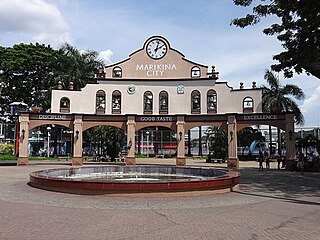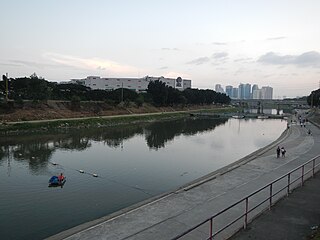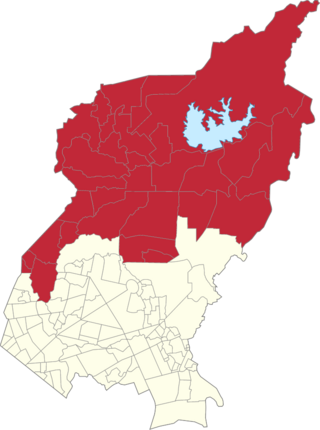Related Research Articles

A barangay, historically referred to as a barrio, is the smallest administrative division in the Philippines and is the native Filipino term for a village, district, or ward. In metropolitan areas, the term often refers to an inner city neighborhood, a suburb, a suburban neighborhood, or even a borough. The word barangay originated from balangay, a type of boat used by a group of Austronesian peoples when they migrated to the Philippines.

Pasig, officially the City of Pasig, is a highly urbanized city in the National Capital Region of the Philippines. According to the 2020 census, it has a population of 803,159 people.

Marikina, officially the City of Marikina, is a 1st class highly urbanized city in the National Capital Region of the Philippines. According to the 2020 census, it has a population of 456,159 people.

Antipolo, officially the City of Antipolo, is a 1st class component city and capital of the province of Rizal, Philippines. According to the 2020 census, it has a population of 887,399 people. It is the most populous city in the Calabarzon region, and the seventh most-populous city in the Philippines. And also, it is the most populated city under the component city status.

Olongapo, officially the City of Olongapo, is a 1st class highly urbanized city in the Central Luzon region of the Philippines. Located in the province of Zambales but governed independently from the province, it has a population of 260,317 people according to the 2020 census.
Elections in the Philippines are of several types. The president, vice-president, and the senators are elected for a six-year term, while the members of the House of Representatives, governors, vice-governors, members of the Sangguniang Panlalawigan, mayors, vice-mayors, members of the Sangguniang Panlungsod/members of the Sangguniang Bayan, barangay officials, and the members of the Sangguniang Kabataan are elected to serve for a three-year term.

Gamu, officially the Municipality of Gamu, is a 4th class municipality in the province of Isabela, Philippines. According to the 2020 census, it has a population of 30,655 people.

The Marikina River is a river in eastern Metro Manila, Philippines. It is the largest tributary of the Pasig River, with headwaters located in the Sierra Madre Mountains in Rodriguez, Rizal province.
In the Philippines, local government is divided into three levels: provinces and independent cities, component cities and municipalities, and barangays, all of which are collectively known as local government units (LGUs). In some area, above provinces and independent chartered cities, is an autonomous region, the Bangsamoro Autonomous Region in Muslim Mindanao is an example. In towns and some cities they remit their revenue to national government and goes back in a form of IRA. Below barangays in some cities and municipalities are sitios and puroks. All of these, with the exception of sitios and puroks, elect their own executives and legislatures. Sitios and puroks are often but not necessarily led by an elected barangay councilor.

A Sangguniang Kabataan is a regional council that represents youth in a barangay in the Philippines. They were put "on hold", but not abolished, prior to the 2013 barangay elections. In January 2016, the Sangguniang Kabataan Reform Act was signed into law, which made changes to the SK and initially scheduled new elections for October 2016. In March 2017, the elections were postponed to May 2018.
Barangay elections were held on Monday, October 28, 2013. The election shall elect the Punong Barangay, more commonly known as barangay captains, and members of the Sangguniang Barangay, or barangay council, in 42,028 barangays throughout the Philippines whose terms start on November 30, 2013. Barangays are the smallest local government unit in the Philippines.
Local elections were held in the Philippines on May 13, 2013, the same day and on the same ballot as national elections. Elected were governors, mayors and council members of Philippine provinces, Philippine cities and Philippine municipalities. Separate elections for barangay officials were held on October.

The Manila City Council or the city's legislature is composed of 38 councilors, with 36 councilors elected from Manila's six councilor districts and two councilors elected from the ranks of barangay (neighborhood) chairmen and the Sangguniang Kabataan. The presiding officer of the council is the Vice Mayor, who is elected citywide.
The Zamboanga City Council is Zamboanga City's Sangguniang Panlungsod or local legislature.

Pinagsama is an administrative division in Metro Manila, the Philippines. It is an urban barangay located in the western portion of Taguig City.
Barangay and Sangguniang Kabataan elections (BSKE) in the Philippines are scheduled to be held on October 30, 2023. The barangay, commonly translated as "village", is the smallest government authority in the country. The election shall elect the barangay captain and seven of eight members of the Sangguniang Barangay in 42,027 barangays throughout the country.

Quezon City's 2nd congressional district is one of the six congressional districts of the Philippines in Quezon City. It has been represented in the House of Representatives of the Philippines since 1987. The district consists of the eastern barangays bordering Marikina, San Mateo and Rodriguez. From 1987 to 2013, it is the most populous district in the country, encompassing the northern part of Quezon City commonly called as Novaliches, until it was redistricted in time for the 2013 election. Just like its pre-2013 composition, it still includes the Batasang Pambansa, the seat of the House of Representatives. It is currently represented in the 19th Congress by Ralph Wendel Tulfo, of the Nacionalista Party (NP).

Marikina's 2nd congressional district is one of the two congressional districts of the Philippines in the city of Marikina. It has been represented in the House of Representatives of the Philippines since 2007. The district was created in 2006 following the passage of Republic Act No. 9364 which amended the 1996 Marikina City Charter. It consists of the northern Marikina barangays of Concepcion Uno, Concepcion Dos, Fortune, Marikina Heights, Parang, Nangka and Tumana bordering Antipolo, Cainta, Quezon City, and San Mateo. It is currently represented in the 19th Congress by Stella Quimbo of the Liberal Party (LP).

Local elections were held in Marikina on May 9, 2022, as part of the Philippine general election. Held concurrently with the national elections, the electorate voted to elect a mayor, a vice mayor, sixteen city council members, and two district representatives to congress. Those elected took their respective offices on June 30, 2022, for a three-year-long term.
References
- 1 2 3 4 5 "Ms. Xyza R. Diazen" (PDF). Marikina City Council. Retrieved 28 April 2013.
- 1 2 3 4 5 "District II Councilor Xyza R. Diazen" . Retrieved 28 April 2013.
- ↑ "Official website of the Commission on Elections" . Retrieved 28 April 2013.
- ↑ Mangunay, Kristine Felisse (2011-02-27). "'Ondoy'-like scenes big no-no to Marikina City councilor". Philippine Daily Inquirer. Retrieved 28 April 2013.
- ↑ "Philippines and Australia Strengthen Political Exchanges" . Retrieved 28 April 2013.